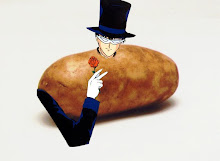I admit that I've never had an interest for Japanese cinema, unless you count Miyazaki and Studio 4C films. But hey, I'm an animation student, give me a break. Either way, I decided to watch Battle Royale recently. It wasn't for class, but rather, I had heard good things about it and since it was right there in the library staring back at me, I thought I'd give it a try. The film as a whole was a really ambitious project, because the whole plot line revolves around killing a class. But, if that's going to phase the audience, we have to get attached to them at the same time. Getting emotionally attached to 20 or 30 kids in the span of two or two and a half hours is a daunting challenge, but I think that Battle Royale accomplished it to the best of its ability. I still admit that there were points nearing the end when I wanted everyone to just blow up so the movie would be over. It did get repetitive. On the other hand, I love how they mainly followed the story of Noriko and Shuya, because you know that only one person had to survive in the end. It made you keep watching to figure out how this couple that you had grown to love was going to either be split, or keep going. Either way, they'd never be the same after the competition. But that's probably just the theme of J-Horror showing: no hope.
After a bit of research, I saw a response to this movie that said that Fukasaku was making fun of the old Japanese war propaganda films. I hadn't thought about this before, but it's true. In fact, just last week I was learning about the cartoons made in Japan during World War II, and I now notice a few similarities between the two. In Battle Royale, there is a scene where a girl meant to resemble some sort of teenage icon stars in a video that tells the students that they'll be killing each other. She talks in a falsely happy voice, laughs, and wears a skimpy uniform. The sickening subject is made worse by the fact that she's just a robot, in a way: relaying information as blandly as if it were the day's lunch menu. In the Japanese wartime cartoons, fairy tales and age-old myths are twisted and bent into tools used by the military to assure the people of Japan that they are doing what's right.
Monday, March 1, 2010
Subscribe to:
Post Comments (Atom)

No comments:
Post a Comment